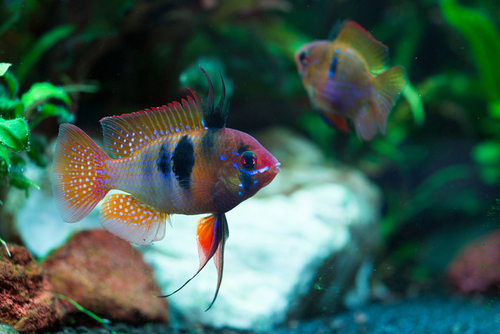Quickly becoming a real favorite in the home aquarium space, the German blue ram cichlid is a very friendly, very peaceful, and very colorful fish that gets along with a wide range of other fish species.
That said, because this fish has flown a little bit under the radar in the home aquarium space for so long there are plenty of people nervous about adding the wrong tank mates into an enclosure and causing all kinds of havoc to break out.
But that’s why we put together this detailed guide.
Below we run through (almost) everything you need to know about finding the best German blue ram tank mates, the perfect fish to share a space with these beauties – all without any headache or worry that there are going to be fish fights (or worse).
Let’s get into it right now.
Contents
German Blue Ram Tank Mates – What You Need to Know
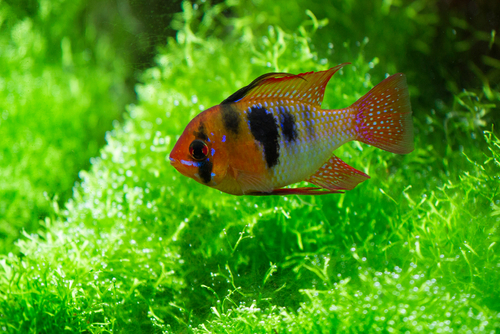
Commonly found in the warmish waters of Colombia and Venezuela, this colorful fish – the German blue ram cichlid – are anything but “wave makers”.
Super calm, super relaxed, and about as peaceful a fish as you are going to find these days you’re not going to have a tough time finding other fish to hang out with your cichlids, that’s for sure.
Even still, to make this process as straightforward as possible you want to think about these core criteria when picking new tank mates:
- The temperament of all the fish you’re going to be adding to an aquarium
- The size of the fish that you will be adding to your aquarium
- Anything that might cause competition or territorial fights to flare up and
- Making sure that the water conditions for your German blue ram cichlids and their tank mates are dialed in
Temperament
Like we’ve mentioned already, German blue ram cichlids are about as easy to care for as it gets thanks to their very peaceful, very relaxed, and almost subdued personality.
These are not fish that are going to want to fight, that are going to want to scrap, or that are going to want to get into all kinds of trouble. No, these fish pretty much get along with everyone and anyone (with rare exceptions).
At the same time, you want to make sure that any of the tank mates you are including in with your German blue rams are calm, peaceful, and docile as well. More aggressive and territorial fish will do everything they can to take advantage of the relaxed nature of your blue ram cichlids.
Size
It’s a good idea to make sure that any of the new tank mates you are adding in with your German blue ram cichlids are about the same size.
These fish grow to be about two or 3 inches in length as full mature adults. Fish that are around the same size aren’t going to fight with cichlids as much as they might with smaller fish.
Larger fish might be tempted to turn your small sized cichlids into lunch, too. Stick to fish that are right around the same size and you’re not going to have to worry about a lot of complications or a lot of surprising fights that you might not have had to worry about otherwise.
Competition
As far as competition is concerned, you won’t have to worry about too much competition coming from your German blue ram cichlids. They just aren’t that feisty and they certainly aren’t described as territorial.
Instead, these fish are very friendly, very peaceful, and about as easy-going a fish as you are going to find. They make very pleasant tank mates for most any of the fish you could drop into the tank with them – provided those fish are pretty peaceful and have a low competition drive, too.
Water Parameters and Tank Setup
Even though these fish are relatively small (really only growing to be 2 or 3 inches long as adults) they do like to have a lot of space in their tank to swim around.
They also like to live in smaller schools of four or five, and that means you want to have a tank that includes at least 20 gallons for them to move around in. On top of that you’ll need to take into consideration how much water your German blue ram tank mates are going to require as well and then work from there.
Be sure to keep your water temperatures somewhere between 72° and 79°F. Water pH levels should be between 5 and 7.5 and you want to use water filtration systems to keep nitrogen levels and other toxins from bubbling up too much inside the aquarium, too.
Tank mates for your German blue ram cichlids should be able to thrive in these same kinds of conditions. You don’t want to stress any of your fish out when keeping them together.
German Blue Ram Tank Mates
Other popular posts you don’t want to miss:
1. Silver Dollars
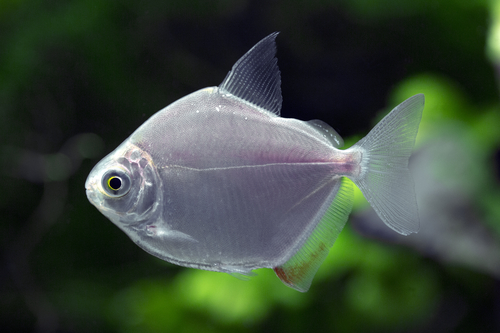
- Scientific Name: Metynnis argenteus
- Adult Size: 6 inches
- Compatible with: Bristlenose, Pleco, Oscar fish
- Water Temperature: 75-82°F
- Minimum tank size: 100 gal
- Care Level: Moderate
Traditionally found in the warmer waters of South America (specifically in the rivers throughout the Amazon River basin in Peru) these beautiful silverfish have a shiny, almost luminescent appearance that gave them their name.
Relaxed, easy to care for, and very friendly, these fish aren’t going to cause any trouble for your German blue ram cichlids – or any other tank mates, for that matter. It’s not a bad idea to keep water temperatures toward the warmer side of things when you have silver dollars in the tank, though.
2. Bristlenose Pleco

- Scientific Name: Ancistrus cirrhosus
- Adult Size: 4-5 inches
- Compatible with: Guppy Fish, Molly Fish, Platy Fish, Swordtail Fish, Corydoras, Gourami
- Water Temperature: 73-80 F
- Minimum tank size: 20 gal
- Care Level: Easy
Definitely one of the most popular fish to keep in a home aquarium thanks to their algae destroying nature, these fish are foolishly easy to keep happy and healthy – and they do a great job at making sure that your tank conditions are happy, too.
One of the biggest reasons these fish are so popular to keep with blue ram cichlids is because they can tolerate a variety of different water conditions. They like it on the warmer side of things but don’t necessarily have to be in the perfect pH balance to thrive.
3. Dwarf Gourami
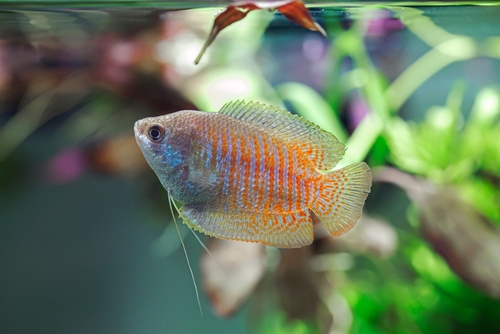
- Scientific Name: Trichogaster lalius
- Adult Size: 3.5 inches
- Compatible with: Angelfish, common mollies, platys, swordtails
- Water Temperature: 75° and 80° F
- Minimum tank size: 10 gal
- Care Level: Easy
The odds of a German blue ram cichlid bumping up against one of these fish in the wild are slim to none, but in aquariums they quickly become fast friends.
Found natively in Asia (especially in the waters of Pakistan and India) this is a fish on the smaller side of things for its species, but that makes it an ideal neighbor and friend for your small German blue ram cichlid fish, too.
These fish are super easy to find, very inexpensive, and thrive in the exact same water conditions that will have your cichlids thriving, too.
4. Rummy Nose Tetras
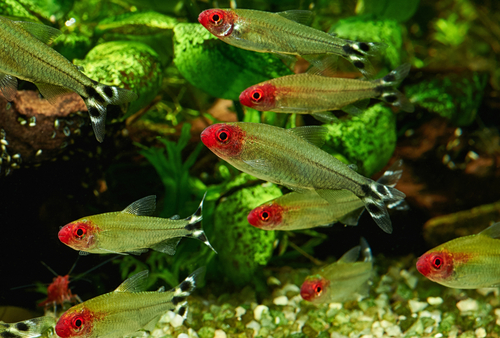
- Scientific Name: Hemigrammus rhodostomus
- Adult Size: 1.5 inches
- Compatible with: Green Neon Tetra, Pearl Gourami, Corydoras Catfish, Hatchetfis, Cherry Barb
- Water Temperature: 64° – 82° F
- Minimum tank size: 20 gal
- Care Level: Easy
Some people in the home aquarium space aren’t in love with the idea of keeping rummy nose tetras in with German blue ram cichlids for a couple of different reasons, not the least of which is that tetras can be a little on the “wild side” of things when they aren’t kept in larger schools.
Add four or five tetras to your tank at a time, though, and you’ll never have to worry about issues bubbling up. Your fish will stay happy, they’ll be very sociable, and they’ll be a lot less stressed out when you take this approach.
5. Honey Gourami
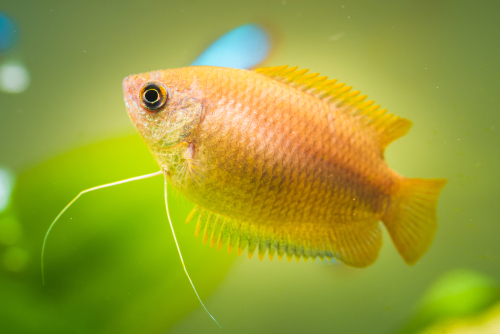
- Scientific Name: Trichogaster chuna
- Adult Size: 2 inches
- Compatible with: Cory catfish, Rasbora, Loaches
- Water Temperature: 71-82 °F
- Minimum tank size: 10 gal
- Care Level: Easy
Even smaller than blue ram cichlids, these fish are never going to threaten or stress out the “main attraction” in your aquarium thanks to the fact that they are nearly half the size of a grown adult.
Very playful (with all kinds of energy), these fish love to be in small schools of five or six. Make sure that you are giving them plenty of company in your tank, though. If they don’t have those small schools to fall in with they become skittish, nervous, and their health really deteriorates.
6. Corydora Catfish
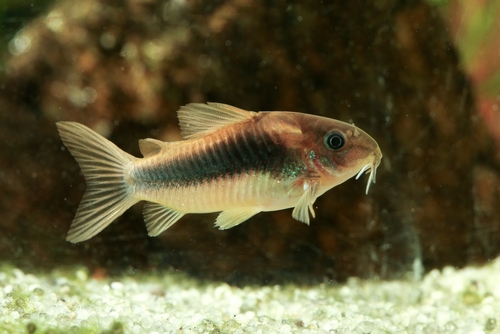
- Scientific Name: Corydoras paleatus
- Adult Size: 2.5 inches
- Compatible with: Almost everything
- Water Temperature: 72-82 F
- Minimum tank size: 20 gal
- Care Level: Easy
Tiny little catfish that are known to be a bit on the prickly side of things when they get challenged, you shouldn’t have to worry about these fish getting into fights with your German blue ram chichlids – just because of how relaxed your chichlids are as a general rule.
Something you might not know about these fish is that they are likely going to outlive and outlast any of the other underwater creatures you’ve added into your aquarium (sometimes by quite a bit). It’s not unusual for these fish to live for 20 years or more with proper care.
7. Discus Fish
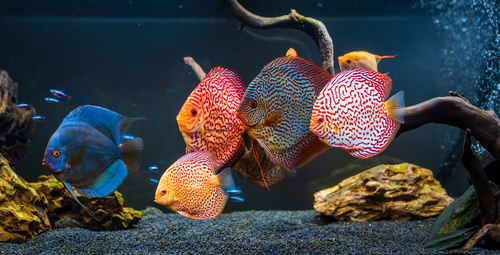
- Scientific Name: Symphysodon
- Adult Size: 6 inches
- Compatible with: Catfish, Loaches, Tetras
- Water Temperature: 82°F
- Minimum tank size: 75 gal
- Care Level: Moderate
These fish can be a handful every now and again, but only because they are so sensitive to toxins in water. As long as you keep nitrogen levels down and regularly refresh your tank (10% every week for 25% every two weeks swapped out) there is not going to be much to worry about.
Though they may not look like predatory fish, they do love to gobble up small invertebrates. Don’t be surprised if they chase your blue ram cichlids around a little bit, though it’s only to have fun!
8. Kuhli Loach
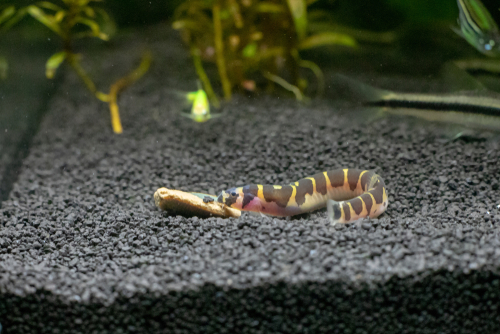
- Scientific Name: Pangio kuhlii
- Adult Size: 3 inches
- Compatible with: Zebrafish, Tetras, Guppies
- Water Temperature: 75-86 °F
- Minimum tank size: 15 gal
- Care Level: Easy
A freshwater fish found natively in Indonesia, these fish are (as a general rule) very relaxed, very even keel, and even a little bit on the shyer side of things.
It’s not a bad idea to keep these fish in small schools of three or four just to give them a boost of confidence. They do like the same kind of water conditions that blue ram cichlids enjoy, though!
9. Guppy Fish

- Scientific Name: Poecilia reticulata
- Adult Size: 1.4 inches
- Compatible with: Cory catfish, mollies, platys, swordfish, loaches, tetras
- Water Temperature: 72 to 82 F
- Minimum tank size: 10 gal
- Care Level: Easy
Even though guppies can sometimes be a little bit skittish (especially when kept with much larger fish), they are amongst some of the best German blue ram tank mates you could find.
Highly adaptable (these fish can do well in brackish water to crystal clear mountain water and everything in between), these fish are found in pretty much every aquarium supply store under the sun – and aren’t going to set you back very much money, either.
10. Molly Fish
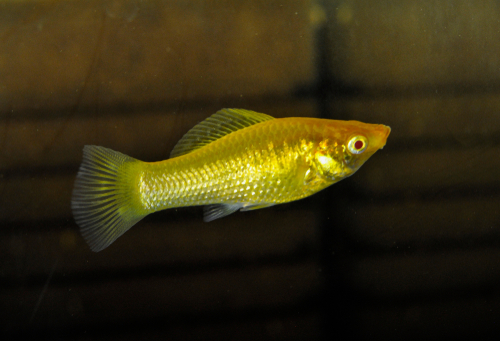
- Scientific Name: Poecilia sphenops
- Adult Size: 6 inches
- Compatible with: Guppy Fish, Endlers, Platy, Swordtail, Neon Tetras
- Water Temperature: 75°-80°F
- Minimum tank size: 10 gal
- Care Level: Easy
Either of the two primary species of Molly fish will do well with your German blue ram cichlids. Both of these species are very friendly, pretty passive, and aren’t going to spend a lot of time in competition with your cichlids, either.
Just make sure that there is a lot of extra room for your cichlids and your mollies to swim around in. If they start to feel penned in they can get frustrated and stressed out quickly.
11. Swordtails
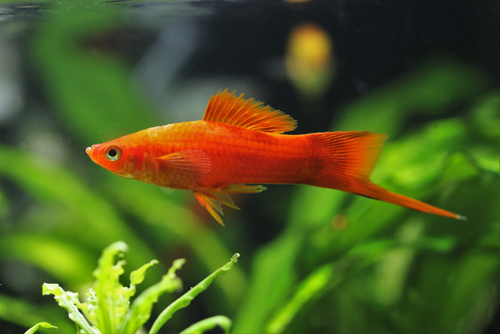
- Scientific Name: Xiphophorus hellerii
- Adult Size: 6.3 inches
- Compatible with: Cory catfish, platys, neon tetra, mollies, guppies
- Water Temperature: 72-79°F
- Minimum tank size: 15 gal
- Care Level: Medium
Native to the waters of Central America (from Mexico to Guatemala and everything in between) these fish are friendly, happy, and generally as peaceful as can be – especially when you keep them in small schools with a male to female ratio of 1:3 or 1:4.
They do best in warmer water (just the same way as your cichlids will) so there isn’t anything to worry about in that department, either.
12. Neon Tetras
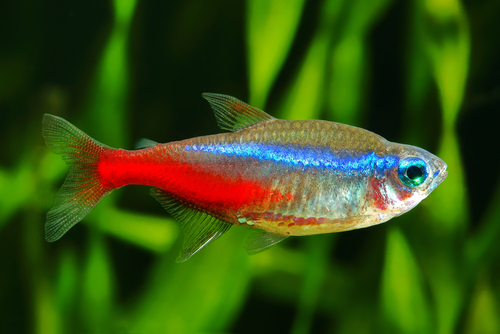
- Scientific Name: Paracheirodon innesi
- Adult Size: 1.5 inches
- Compatible with: Cory catfish, guppies, tetras, loaches
- Water Temperature: 75° – 80° F
- Minimum tank size: 10 gal
- Care Level: Medium
Tetras have a bit of a goofy reputation for being aggressive or territorial, but as long as they have a lot of extra room to swim around in you won’t have much to worry about.
Neon tetras do really well with German blue ram cichlids. They like the same foods for the most part, they like the same water conditions for the most part, and because they are similarly sized (with the cichlids just a little bit larger) there isn’t a lot of competition or aggression to be concerned with.
13. Zebra Danios
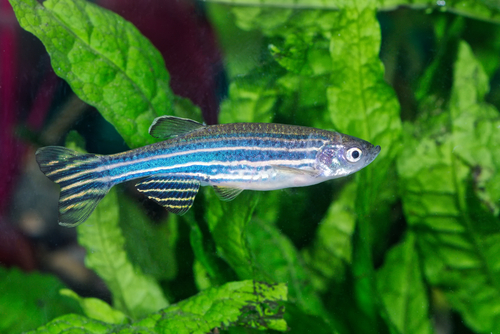
- Scientific Name: Danio rerio
- Adult Size: 1.5 inches
- Compatible with: Catfish, guppies, platys, mollies, swordtails
- Water Temperature: 64 – 75 °F
- Minimum tank size: 10 gal
- Care Level: Easy
Zebra danios can come in a bunch of different colors, but they always have zebra-like stripes running across their body. Commonly found in the East Indies, the same water conditions that your blue ram cichlids enjoy are going to be picture-perfect for these fish, too.
If you have the space to accommodate six of them (but no more) they will school up and it’ll help a lot with their mental health and behavior.
14. Rubber Lip Pleco
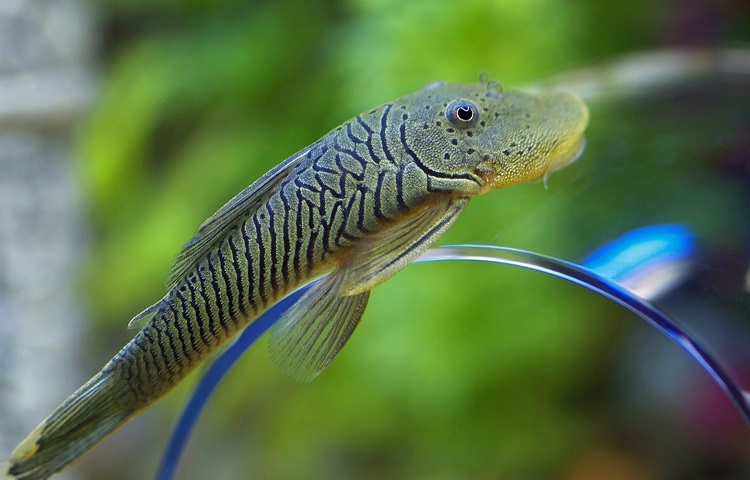
- Scientific Name: Chaetostoma milesi
- Adult Size: 7 inches
- Compatible with: Neon tetras, Gourami, Catfish
- Water Temperature: 70-78 °F
- Minimum tank size: 30 gal
- Care Level: Easy
A bottom dwelling fish that uses their sucker mouth to help keep your tank clean, these fish are going to live almost exclusively in the lower half of the water column of your aquarium – and that means they’re just not going to have a lot of interaction with your blue ram cichlids.
Because of that they make wonderful tank mates, especially when space is at a premium.
Closing Thoughts
So there you have it, our picks for the best German blue ram tank mates in the home aquarium space today.
The best thing about all of these different fish is that you can kind of mix and match them together, too. They all have generally peaceful natures, they all get along well with one another, and they are all around the same size.
Don’t be shy about adding a couple of different fish we highlighted above together. You’ll jack up your tank diversity, add a lot of energy and interest into your tank, and keep your fish a lot happier, too!
Frequently Asked Questions
Should you add tank mates in with your German blue rams?
While you could certainly keep blue rams alone, they do seem to live healthier and happier lives when they have tank mates to share a space with.
Are German blue rams really peaceful?
There’s a reputation out there about some cichlids that they can be a handful and a little on the aggressive side of things. You won’t have to worry about that with blue rams, though!
How many different kinds of tank mates can you add in with German blue rams?
There’s no real limit to the amount of tank mates you can add in with your chichlids. Just make sure you have the tank space, plenty of food, and are only ever mixing fish that will get along with all the rest of the underwater creatures in your tank.

Ian Sterling, founder of Fishlab.com, began his aquarium journey over 30 years ago, driven by a deep fascination for fish and their diverse personalities. His website, Fishlab.com, is dedicated to making fishkeeping accessible and enjoyable, offering beginner-friendly guidance, expert insights, and a community for aquarists to connect and share experiences.


